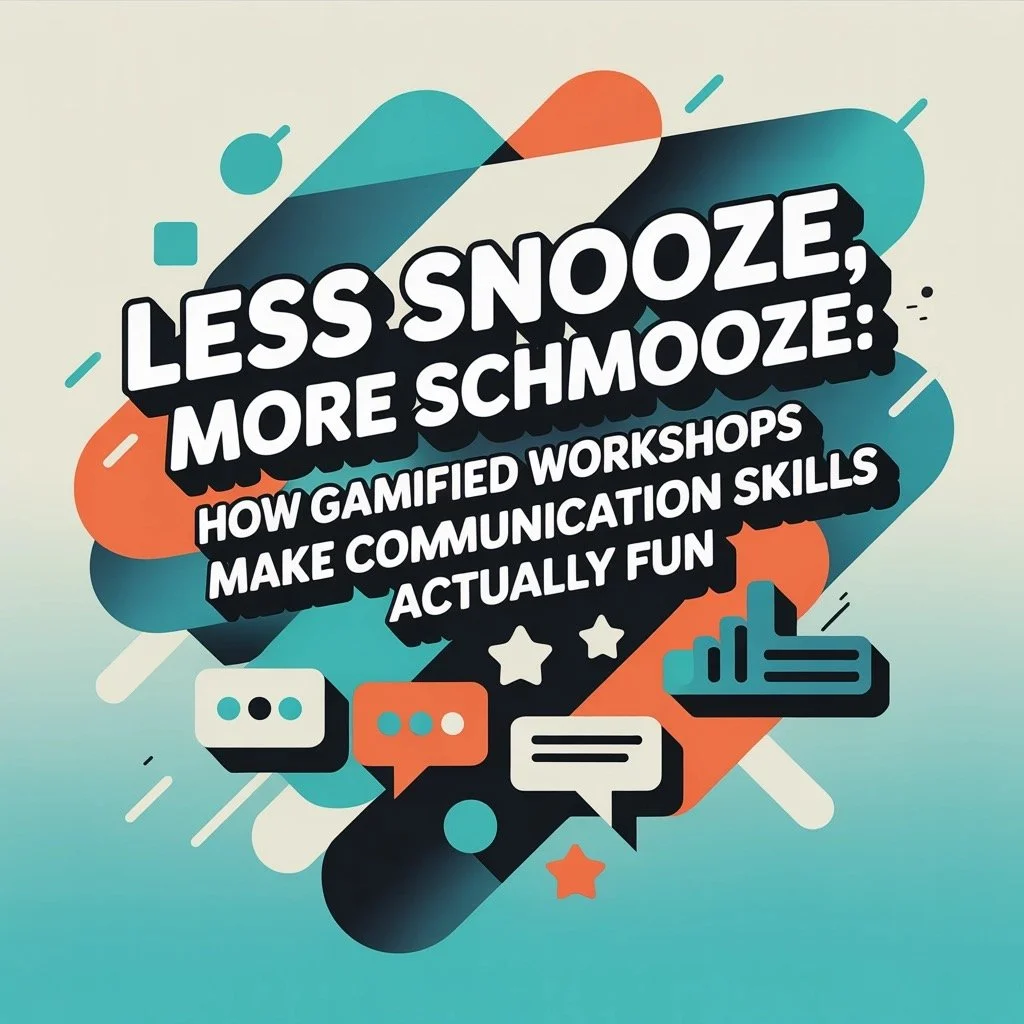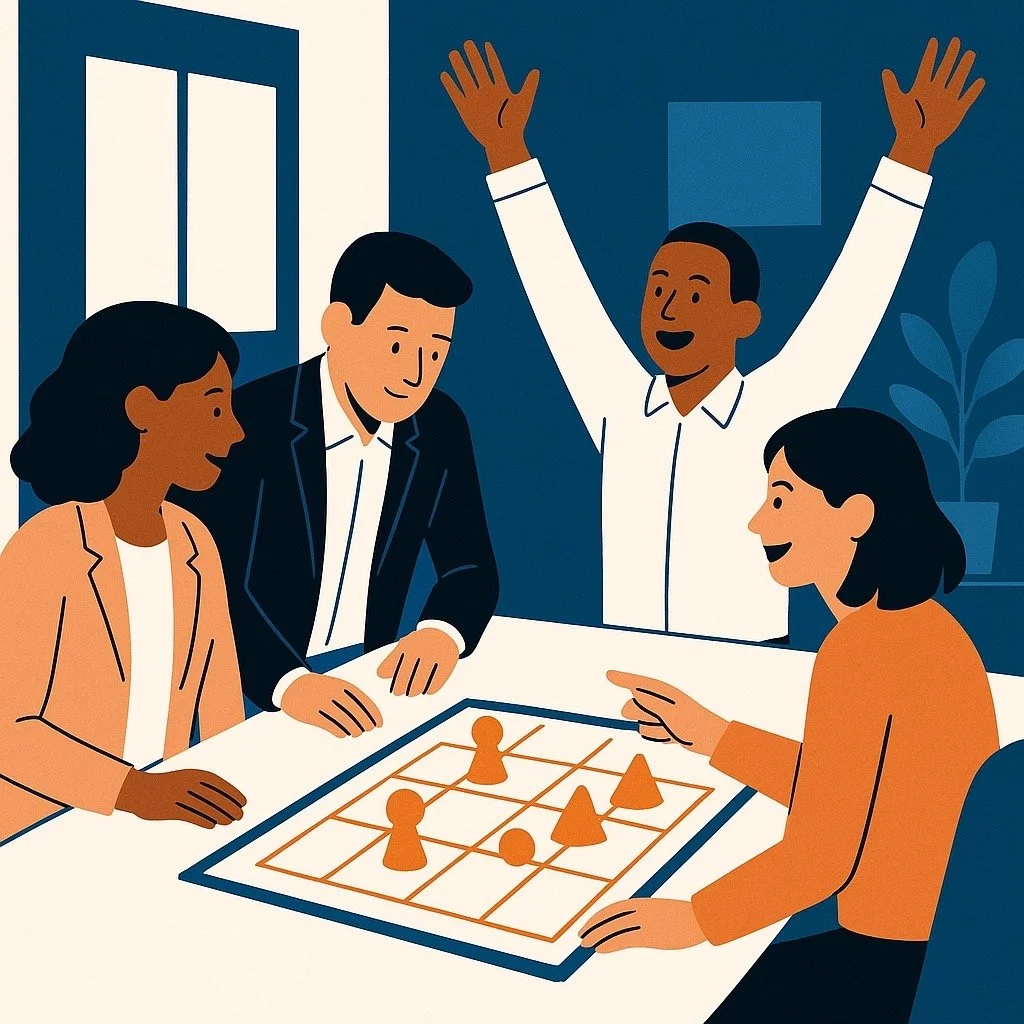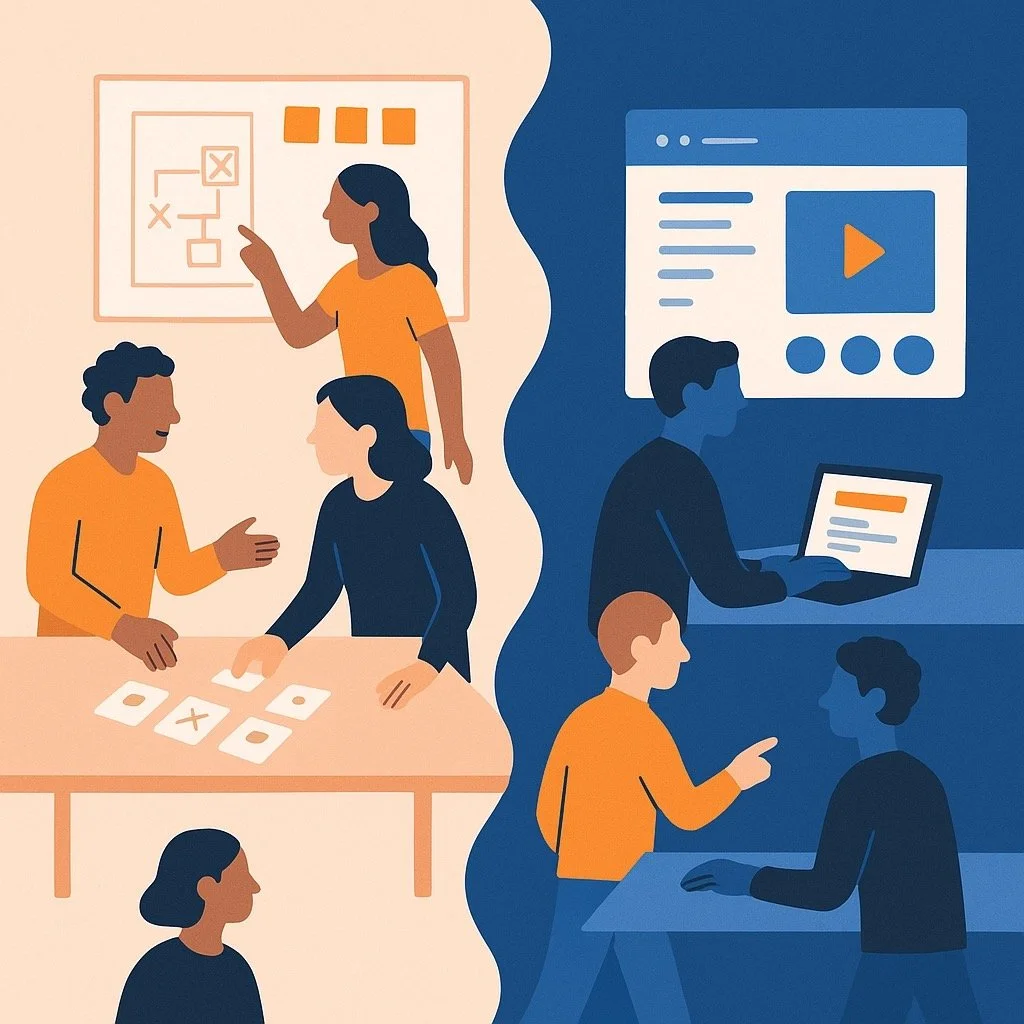Less Snooze, More Schmooze: How Gamified Workshops Make Communication Skills Actually Fun
Let's face it—traditional communication workshops can be about as exciting as watching paint dry. We've all been there: sitting in a stuffy conference room while someone drones on about "active listening" and "effective feedback loops." You're nodding along, but secretly you're plotting your escape or mentally redecorating your living room.
But what if I told you that learning essential communication skills could actually be... fun? Not just tolerable, but genuinely enjoyable? At Chatterbox Workshops, we've discovered that gamification isn't just a buzzword—it's the secret sauce that transforms dry training into memorable experiences that actually stick.
Why Traditional Communication Training Puts People to Sleep
Before we dive into the game-changing power of gamification (see what I did there?), let's acknowledge the elephant in the room: traditional communication training often fails spectacularly.
The problems are painfully familiar:
Death by PowerPoint: Slide after slide of communication theories with no practical application
Attention black holes: Research shows attention spans in traditional training plummet after just 8-10 minutes
The forgetting curve: Participants retain less than 10% of information delivered in lecture format after just one week
Zero emotional investment: When training feels like a chore, participants emotionally check out
The harsh truth? Your team might physically attend that communication workshop, but their brains are often on vacation.
Game On: Why Gamification Works Where Traditional Training Fails
Gamification isn't about turning your workplace into a video arcade. It's about understanding human psychology and using game mechanics to tap into our natural motivations.
Here's why gamification works so well for communication skills specifically:
1. Communication is Inherently Social—Just Like Games
Communication doesn't happen in isolation—it's a dynamic, social activity. Games create natural social environments where communication skills can be practiced authentically. When participants are focused on winning a communication-based game, they're actually practicing real-world skills without the self-consciousness that comes with traditional role-playing.
2. Games Create Emotional Engagement
Emotional connection is the superglue of memory. When you feel something during learning—excitement, surprise, even friendly competitive stress—your brain pays attention and retention skyrockets. Games trigger these emotional responses naturally, making lessons stick.
3. Immediate Feedback Loops
In traditional training, feedback is often delayed or generalized. In gamified workshops, participants receive instant feedback on their communication choices. Did your team understand your instructions? The obstacle course results will tell you immediately. Was your negotiation approach effective? The points on the scoreboard don't lie.
4. Low-Stakes Practice in High-Stakes Skills
Communication failures in the workplace can be costly—damaged relationships, missed opportunities, project failures. Games provide consequence-free environments to practice and even fail at communication skills before they matter in real workplace scenarios.
Real-World Gamification: Communication Activities That Actually Work
Enough theory—let's get practical. Here are some of our most successful gamified communication activities that consistently transform even the most reluctant participants into engaged communicators:
The Instruction Challenge
How it works: Teams of three take turns with different roles: Instructor, Builder, and Observer. The Instructor must verbally guide the Builder to recreate a simple object or pattern without seeing what they're doing. The Observer takes notes on communication effectiveness.
Skills developed: Clear instruction-giving, clarifying questions, active listening, adapting communication style based on feedback
Why it works: The immediate visual feedback (the built object) shows exactly how effective the communication was, creating natural "aha!" moments about clarity and precision in communication.
Communication Bingo
How it works: Participants receive bingo cards featuring common communication mistakes or successes. During various mini-activities throughout the day, they mark their cards when they spot these behaviors in themselves or others.
Skills developed: Communication awareness, pattern recognition in conversation, self-monitoring
Why it works: It turns communication awareness into a day-long game, encouraging participants to actively analyze communication patterns they might otherwise ignore.
The Emoji Translator
How it works: Complex workplace scenarios are presented using only emoji sequences. Teams compete to correctly interpret the situation and then create appropriate responses—first in emojis, then translated into professional communication.
Skills developed: Reading non-verbal cues, emotional intelligence, message clarity, adapting communication to different formats
Why it works: It makes the often invisible emotional layer of communication visible and playful, helping participants recognize how much information is conveyed beyond words.
Beyond Fun: The Serious Business Impact of Gamified Communication Training
While fun is a critical component of gamified workshops, the business results are what really matter. Here's what our clients consistently report after switching to gamified communication training:
Extended attention spans: Participants stay engaged for the entire workshop—some even ask to continue activities during breaks!
Dramatically improved retention: Follow-up assessments show 65-70% higher retention rates compared to traditional training methods
Faster skill application: Teams implement new communication techniques within days rather than weeks
Reduced resistance to training: Workshop attendance and voluntary participation increase significantly
Cross-departmental relationship building: Games naturally break down silos and create connections across team boundaries
As one participant from a recent Chatterbox workshop put it: "I've been to five communication trainings in my career, and this is the first one where I didn't check my email once. More importantly, it's the first one where I actually changed how I communicate with my team."
How to Gamify Your Team's Communication Development
Ready to level up your team's communication training? Start with these principles:
1. Focus on Skills, Not Points
The most effective gamification puts learning objectives first. Identify the specific communication skills your team needs to develop, then build game mechanics around those skills. Points, badges, and leaderboards should support learning, not distract from it.
2. Keep Competition Healthy
Competition can drive engagement, but too much can create anxiety that blocks learning. Design games where teams compete against challenges rather than each other, or where collaboration between competitors is necessary for success.
3. Mix Digital and Analog
While digital gamification platforms offer sophisticated tracking and varied activities, don't underestimate the power of physical games. Moving around the room, manipulating objects, and face-to-face interaction create multi-sensory learning experiences that enhance retention.
4. Reflect and Connect
Games provide the engagement, but reflection provides the learning. Build in short debriefs after each activity where participants can connect game experiences to workplace communication challenges. These connections transform fun into lasting behavior change.
The Dark Side: Gamification Pitfalls to Avoid
Not all gamification is created equal. Avoid these common mistakes:
Style over substance: Flashy game mechanics without clear learning objectives create entertainment, not education
One-size-fits-all approaches: Different personalities respond to different game styles—variety is essential
Mandatory "fun": Forced participation in games can create resistance—allow different levels of engagement
Complexity overload: If understanding the game takes more energy than practicing the skills, simplify immediately
The Future is Fun: Where Communication Training is Headed
Communication skills have never been more important in the workplace, especially as teams become more diverse, remote, and cross-functional. The organizations gaining competitive advantage aren't just prioritizing communication training—they're reinventing how it happens.
The future of communication training combines gamification with other emerging approaches like microlearning, AI-powered personalization, and mixed reality. Imagine practicing difficult conversations with an AI character that adapts to your communication style, or using augmented reality to visualize communication patterns within your team in real-time.
At Chatterbox Workshops, we're constantly exploring these frontiers while staying grounded in what works: human connection, practical skill-building, and yes—making learning genuinely enjoyable.
Ready to Transform Your Team's Communication Skills?
If your team has been snoozing through traditional communication training, it's time for a change. Gamified workshops don't just make learning more fun—they make it more effective, creating lasting behavior change that transforms workplace communication.
Whether you're dealing with conflict resolution, feedback skills, cross-cultural communication, or leadership development, there's a gamified approach that can revolutionize how your team learns and grows together.
Because when it comes to essential workplace skills, who says effective can't also be enjoyable?
Ready to bring more play and less yawn to your team's development? Check out our game-changing approach to workplace learning or explore our specialized team development programs.
Game on!




